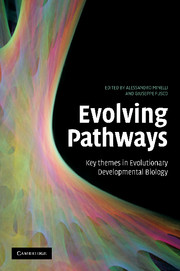Book contents
- Frontmatter
- Contents
- Contributors
- Preface
- Introduction: Pathways of change
- Part I Thinking about evolution by taking development on board
- Part II Evo-devo: methods and materials
- Part III Evolving diversity
- 12 Unravelling body plan and axial evolution in the Bilateria with molecular phylogenetic markers
- 13 Are transposition events at the origin of the bilaterian Hox complexes?
- 14 Many roads lead to Rome: different ways to construct a nematode
- 15 Basal euarthropod development: a fossil-based perspective
- 16 Developmental transitions during the evolution of plant form
- Part IV Evolving body features
- Index
- References
15 - Basal euarthropod development: a fossil-based perspective
Published online by Cambridge University Press: 08 August 2009
- Frontmatter
- Contents
- Contributors
- Preface
- Introduction: Pathways of change
- Part I Thinking about evolution by taking development on board
- Part II Evo-devo: methods and materials
- Part III Evolving diversity
- 12 Unravelling body plan and axial evolution in the Bilateria with molecular phylogenetic markers
- 13 Are transposition events at the origin of the bilaterian Hox complexes?
- 14 Many roads lead to Rome: different ways to construct a nematode
- 15 Basal euarthropod development: a fossil-based perspective
- 16 Developmental transitions during the evolution of plant form
- Part IV Evolving body features
- Index
- References
Summary
The morphological gap between Euarthropoda (the crown group that contains all extant arthropods) and living arthropod-like animals such as onychophorans, tardigrades and pentastomids is bridged by a number of fossils known primarily from rocks some 520 to 490 million years old (e.g. Fuxianhuia, Chengjiangocaris, Shankouia, see Figure 15.1; cf. Waloszek et al. 2005). These centimetre-scale fossil animals illuminate critical steps in early arthropod evolution (particularly head and limb development) but provide a limited amount of developmental information because of a lack of early ontogenetic stages. Small individuals that might represent pre-mature stages are scarce or absent, and the degree of allometry among the available individuals is generally modest. A limited number of early arthropod taxa do show more substantial ontogenetic information (Waloszek and Maas 2005). This chapter reviews the morphological development of early arthropods from two perspectives. The first is that provided by ontogenetic series based on the well-preserved biomineralised exoskeletons of trilobites, the best represented arthropod taxon in Palaeozoic rocks, but one whose development is seldom considered in broader comparative context. The second is that provided by ‘Orsten’-type preserved faunas, in which the entire cuticle of numerous post-embryonic specimens of various species, mainly representatives of the crustacean evolutionary lineage (stem derivatives and Labrophora with phosphatocopines and members of the Eucrustacea; see Maas and Waloszek 2005) was replaced with spectacular fidelity by calcium phosphate in the absence of any compaction (Müller 1985).
Information
- Type
- Chapter
- Information
- Evolving PathwaysKey Themes in Evolutionary Developmental Biology, pp. 281 - 298Publisher: Cambridge University PressPrint publication year: 2008
References
Accessibility standard: Unknown
Why this information is here
This section outlines the accessibility features of this content - including support for screen readers, full keyboard navigation and high-contrast display options. This may not be relevant for you.Accessibility Information
- 15
- Cited by
